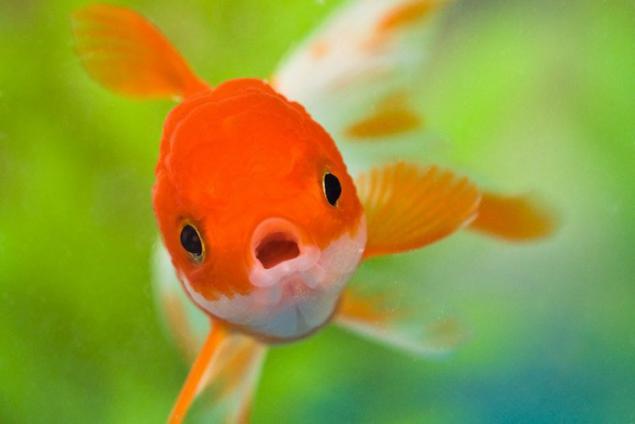1198
Oibochka occurred
Starting from childhood, we have learned a lot about the animals - from the school course, books or TV shows. But sometimes it happens that our ideas about animals, like many other concepts, not quite true. While the media is perfectly do their job to entertain the audience, they often give false information when it comes to learning new things. In this issue we look at ten popular and enduring myths about animals.

1. Toads

Myth: from touching frogs grow warts.
It's surprisingly common misconception, and many people with Google trying to find out whether there is some truth in this assertion. And the truth is that in it there is no truth at all. This myth is most likely related to the fact that parents usually tell their children not to touch the toads just found in the mud. However, it appears that the warts can catch almost any location, their causes human papilloma virus - but it has nothing to do with the toads. However, parents can still find their children a good reason not to touch the toads: zhabya skin contains Bufotoxin, which can cause irritation.
2. Goldfish

Myth: goldfish bad memory.
Another common myth is that goldfish have a very short memory, and that they are very stupid. It appears, in fact, goldfish quite intelligent creatures, and probably would not be happy in such attempts to denigrate their intelligence. Memory of a goldfish actually quite developed, they are able to remember some events of the week and taught the difficult tasks. Among the complex tasks they were trained, pushing levers, bells, - in other words, they are almost as smart as rats.
3. Cheetahs

Myth: cheetah - the fastest animal in the world.
This statement is the truth, because the cheetah - the fastest land animal in the world, at short distances it reaches a speed of 109 km / h, exceeding the speed limit on many US highways. However, the cheetah is not the fastest animal on the planet, that title belongs to the bird. Chaetura Swift is the fastest living creature on the planet: the horizontal flight, he is capable of speeds over 111 km / h. A close relative of this bird was faster, but the record is not considered formally by scientists, because the way that was carried out this test was not considered scientific. In addition, the fastest fish in the world, sailboats substantially divide cheetahs second floating at a speed 109 km / h.
4. Pholcidae

Myth: Poison Pholcidae more poisonous than any other spider venom, but fortunately, the spider can not bite through human skin.
Many believe that Pholcidae extremely poisonous. At the same time there is a misconception that their mouths are too small to bite humans. These popular misconceptions were refuted famous "Mythbusters" with the help of the experiment, during which the spider successfully bitten the hand of Adam. "The Destroyer" admitted that he did not feel anything except a very weak instantaneous burning at the site of the bite. Analysis showed that these spiders are not venomous and harmless to humans.
5. Ostriches

Myth: ostriches bury their heads in the sand.
This is one of those myths that are incredibly ingrained, mostly thanks to the numerous cartoons and caricatures that make us perceive this "ostrich habits of" granted. We have all heard that when someone does not want to deal with the problem, "they dive head in the sand like an ostrich," supposedly so birds do when near danger. Meanwhile, ostriches tend to run away if they feel the approach of danger, and quite able to defend themselves with powerful blows of the beak or feet. In reality, when the potential danger of ostriches just dipped his head lower to them harder to notice.
6. Bulls

Myth: bull into a rage of red.
Testing on the mechanical bull matador with cloths of different colors (fixed and fluctuating), experiments have shown that bull zvereet from vibrating rags instead of red, or the silhouette of man. Finally, the expert had "deadly trick", after standing motionless on the floor in a red suit, while two professional cowboy bull teased. In general, despite the fact that the bulls distinguish colors (they Dichromacy) they react to the movement.
7. Snakes

Myth: snakes hear and respond to music.
Spell snakes - one of the most interesting and at the same time dangerous stunts. Snake charmers playing the flute, and the snake sways to the music enchanted soothing notes. Well, except for the fact that everything in the last sentence is not true. It turns out that the snake can not hear what people are doing, they can feel the vibrations, and during a spell of the snake actually react to the motion made by the fakirs, and not to the sound of the flute. It turns out that, like many street performers, snake charmers are more worried about making it their view was spectacular. Do not forget that the fakirs can do poorly with their creeping artists: many snakes carry dangerous and painful procedure - removal of canines.
8. Koalas

Myth: koala - it bears.
Many people mention about nice little furry creatures that live on eucalyptus in Australia, talking about them "koala bears." This definition is quite understandable, because these animals really look like miniature bears, but they are actually marsupials. Koala marsupial considered because it has a pocket, which is devoid of bears. It turns out that in fact much closer to the koalas wombats than to bears.
9. Dogs

Myth: The old dog new tricks You can not teach.
Many have heard the expression, and not only remembered, but also took it for granted. Studies have been conducted on older dogs, and found that with proper training, they were able to learn new tricks, like young dogs.
10. Dolphins

Myth: The Dolphins are always friendly and willing to help.
There is one thing that usually say with confidence: always support human dolphins in the ocean, rescued from sharks and help you find the way to the bank. The reality is not so rosy - sometimes dolphins can be a killer! Recently, scientists have made some very disturbing discoveries about dolphins and how they tortured to death dolphin. The fact remains - the dolphins harm their fellows.

1. Toads

Myth: from touching frogs grow warts.
It's surprisingly common misconception, and many people with Google trying to find out whether there is some truth in this assertion. And the truth is that in it there is no truth at all. This myth is most likely related to the fact that parents usually tell their children not to touch the toads just found in the mud. However, it appears that the warts can catch almost any location, their causes human papilloma virus - but it has nothing to do with the toads. However, parents can still find their children a good reason not to touch the toads: zhabya skin contains Bufotoxin, which can cause irritation.
2. Goldfish

Myth: goldfish bad memory.
Another common myth is that goldfish have a very short memory, and that they are very stupid. It appears, in fact, goldfish quite intelligent creatures, and probably would not be happy in such attempts to denigrate their intelligence. Memory of a goldfish actually quite developed, they are able to remember some events of the week and taught the difficult tasks. Among the complex tasks they were trained, pushing levers, bells, - in other words, they are almost as smart as rats.
3. Cheetahs

Myth: cheetah - the fastest animal in the world.
This statement is the truth, because the cheetah - the fastest land animal in the world, at short distances it reaches a speed of 109 km / h, exceeding the speed limit on many US highways. However, the cheetah is not the fastest animal on the planet, that title belongs to the bird. Chaetura Swift is the fastest living creature on the planet: the horizontal flight, he is capable of speeds over 111 km / h. A close relative of this bird was faster, but the record is not considered formally by scientists, because the way that was carried out this test was not considered scientific. In addition, the fastest fish in the world, sailboats substantially divide cheetahs second floating at a speed 109 km / h.
4. Pholcidae

Myth: Poison Pholcidae more poisonous than any other spider venom, but fortunately, the spider can not bite through human skin.
Many believe that Pholcidae extremely poisonous. At the same time there is a misconception that their mouths are too small to bite humans. These popular misconceptions were refuted famous "Mythbusters" with the help of the experiment, during which the spider successfully bitten the hand of Adam. "The Destroyer" admitted that he did not feel anything except a very weak instantaneous burning at the site of the bite. Analysis showed that these spiders are not venomous and harmless to humans.
5. Ostriches

Myth: ostriches bury their heads in the sand.
This is one of those myths that are incredibly ingrained, mostly thanks to the numerous cartoons and caricatures that make us perceive this "ostrich habits of" granted. We have all heard that when someone does not want to deal with the problem, "they dive head in the sand like an ostrich," supposedly so birds do when near danger. Meanwhile, ostriches tend to run away if they feel the approach of danger, and quite able to defend themselves with powerful blows of the beak or feet. In reality, when the potential danger of ostriches just dipped his head lower to them harder to notice.
6. Bulls

Myth: bull into a rage of red.
Testing on the mechanical bull matador with cloths of different colors (fixed and fluctuating), experiments have shown that bull zvereet from vibrating rags instead of red, or the silhouette of man. Finally, the expert had "deadly trick", after standing motionless on the floor in a red suit, while two professional cowboy bull teased. In general, despite the fact that the bulls distinguish colors (they Dichromacy) they react to the movement.
7. Snakes

Myth: snakes hear and respond to music.
Spell snakes - one of the most interesting and at the same time dangerous stunts. Snake charmers playing the flute, and the snake sways to the music enchanted soothing notes. Well, except for the fact that everything in the last sentence is not true. It turns out that the snake can not hear what people are doing, they can feel the vibrations, and during a spell of the snake actually react to the motion made by the fakirs, and not to the sound of the flute. It turns out that, like many street performers, snake charmers are more worried about making it their view was spectacular. Do not forget that the fakirs can do poorly with their creeping artists: many snakes carry dangerous and painful procedure - removal of canines.
8. Koalas

Myth: koala - it bears.
Many people mention about nice little furry creatures that live on eucalyptus in Australia, talking about them "koala bears." This definition is quite understandable, because these animals really look like miniature bears, but they are actually marsupials. Koala marsupial considered because it has a pocket, which is devoid of bears. It turns out that in fact much closer to the koalas wombats than to bears.
9. Dogs

Myth: The old dog new tricks You can not teach.
Many have heard the expression, and not only remembered, but also took it for granted. Studies have been conducted on older dogs, and found that with proper training, they were able to learn new tricks, like young dogs.
10. Dolphins

Myth: The Dolphins are always friendly and willing to help.
There is one thing that usually say with confidence: always support human dolphins in the ocean, rescued from sharks and help you find the way to the bank. The reality is not so rosy - sometimes dolphins can be a killer! Recently, scientists have made some very disturbing discoveries about dolphins and how they tortured to death dolphin. The fact remains - the dolphins harm their fellows.























